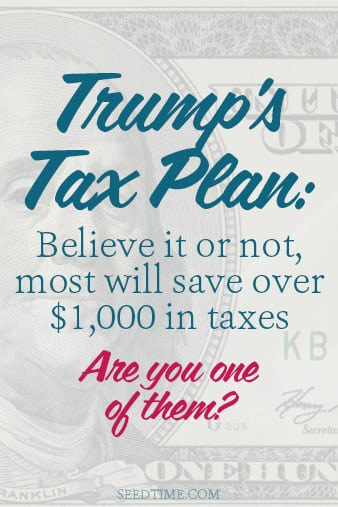 Whether you love Donald Trump or whether you are booking your flight to Canada, there’s no getting around that he has officially been voted into the Oval Office.
Whether you love Donald Trump or whether you are booking your flight to Canada, there’s no getting around that he has officially been voted into the Oval Office.
I think everyone was surprised to see him win and that is okay, but now that he has I am curious to explore some of what lies ahead with his presidency.
This is no way an endorsement of Trump or his tax plan, but rather an explanation of his plan based on the current info that we have.
All that said, most of us can agree that the US tax code is in serious need of reform. And given the lackluster state of the economy, a tax cut of some sort is probably long overdue and will be welcomed by many.
Time will tell, but Trump’s tax plan might accomplish both goals: simplification and lower taxes.
So the real questions are, what are the details of the tax plan, and how will it affect you?
Let’s try to address both questions based on the information that we currently have about the tax plan.
Individual Income Taxes
The Trump Tax Plan will generally lower income tax rates, while completely eliminating certain other tax categories.
Tax Rates
With the Trump Tax Plan, the number of income tax brackets will be reduced from seven down to just three:
- Income less than $75,000 for married filing jointly (or $37,500 for single filers) – 12%
- Income greater than $75,000 but less than $225,000 for married filing jointly (or between $37,500 and $112,500 for single filers) – 25%
- Income greater than $225,000 for married filing jointly (or more than $112,500 for single filers) – 33%
Notice that in each of the three brackets, the applicable income for single filers is exactly half that of those who are married filing jointly. Under current tax law, the tax brackets are 10%, 15%, 25%, 28%, 33%, 35%, and 39.6%.
Under this change, most taxpayers – but not all – will be subject to lower marginal income tax rates.
Capital Gains Tax Rate
Under the Trump plan, the current capital gains rate will be retained. That means that the capital gains tax rate will top out at 20% for investment assets that have been sold after being held for more than one year.
Alternative Minimum Tax (AMT)
The AMT is a provision in the tax code that adds back certain tax preference items into your adjusted gross income. It is designed to impose a tax on wealthy individuals who may minimize or eliminate their tax liability through the use of certain deductions and loopholes.
The problem with the AMT is that it is not indexed for inflation. That imposes “bracket creep” in which many middle-class taxpayers are now subject to the additional tax.
The Trump Tax Plan proposes to eliminate the AMT.
Obamacare Tax on Investment Income
This is a tax that was included in the Affordable Care Act, a.k.a., Obamacare, that imposes a 3.8% tax on investment income received by high income taxpayers. It was established to partially fund the Act.
This tax will also be eliminated under the Trump Tax Plan.
Death Tax, or Estate Tax
Under current tax law, an estate tax of up to 40% can be charged on estates that are valued at more than $5.45 million.
Under the Trump Tax Plan, this tax will generally be eliminated. However, the new plan will be subject to capital gains held until death and valued at over $10 million. In addition, contributions of appreciated assets into a private charity created by either the decedent or the decedent’s relatives will be disallowed.
Individual Deductions
There will be significant changes on this front as well, and most will benefit the average taxpayer.
Standard Deduction
Under current tax law, the standard deduction for a married couple filing jointly is $12,600, and for single filers, $6,300 (both for 2016). Under the Trump plan, the standard deduction will increase to $30,000 for married couples, and $15,000 for single filers.
Personal Exemptions
Under current tax law, taxpayers can deduct $4,050 for each member of the household (taxpayer, spouse, and eligible dependents). Under the Trump plan, personal exemptions will be eliminated. The general idea is that they will be included in the higher standard deduction. If you are single and earn $50,000 – on which only $35,000 would be taxable after taking the $15,000 deduction – your marginal tax rate would be 12%. That’s better than the 25% marginal tax bracket that it would be in under the current tax code.
Head of Household Filing Status
This tax filing status will be eliminated under Trump’s proposal.
Limitation on Itemized Deductions
Under the Trump Tax Plan, itemized deductions will be capped at $200,000 for taxpayers who are married filing jointly, and $100,000 for single filers.
For what it’s worth, the current tax system also provides for the phaseout of itemized deductions beginning with an income of $259,400 for single filers, and $311,300 for married filing jointly.
Child Care Deduction
Under Trump’s tax proposal, you will be entitled to take an “above the line” deduction (applies even if you don’t itemize) for children under the age of 13. The deduction will be capped at the state average for the age of the child, and also for eldercare for a dependent.
The deduction will apply to incomes of below $250,000 for single filers, or $500,000 for married filing jointly. According to the plan, working and middle-class families will see the largest percentage reduction in the amount of their taxable income because of this deduction.
The exclusion will apply to families who use stay-at-home parents or grandparents, as well as paid caregivers. There will be a limit of four children per taxpayer, and the eldercare exclusion will top out at $5,000 per year, but will be indexed to the rate of inflation.
Childcare Rebate
The plan would offer spending rebates for childcare to certain low income taxpayers through the Earned Income Tax Credit (EITC). It would be equal to 7.65% of the remaining eligible child care expenses, and limited by a cap equal to half of the payroll taxes paid by the taxpayer. It would be based on the income of the lower earning parent in a two income household.
The rebates will be available to single taxpayers earning $31,200 or less, or to married couples filing jointly on incomes of $62,400 or less.
Dependent Care Savings Accounts (DCSAs)
These are special savings accounts that can be set up for the benefit of specific individuals, which includes unborn children. All taxpayers will be eligible.
Contributions will be limited to $2,000 per year from all sources, including the account owner, immediate family members, or the employer of the account owner. The government will provide a 50% match on contributions by parents of up to $1,000 per year per household. Parents will be able to check a box on their tax returns that will create a direct deposit of any portion of their EITC into their DCSA account(s).
Both deposits and earnings will be free from taxes, and unused balances can be rolled over from one year until the next. Once the child reaches 18 the funds in the account can be used to pay for education related expenses.
Business Income Taxes
This is a tax change that Donald Trump often discussed during the campaign and in the debates. While it’s likely that most people interpreted the reduction in the business income tax rate as applying to large corporations, it actually applies to small businesses as well.
Under the Trump Tax Plan, the business tax rate will fall from the current level of 35% (the current top corporate tax rate), down to 15%. The plan will also eliminate the corporate alternative minimum tax. This rate is available to all businesses, including corporations, sub-chapter S corporations, partnerships and sole proprietorships.
That rate will be available to all businesses, including small businesses, and will apply to profits that are retained within the business.
It also provides a one time 10% tax rate on corporate profits held offshore that are repatriated back into the US. This is an obvious aim at getting large, multinational corporations to bring their capital back into the US.
Business Tax Deductions
The Trump Tax Plan eliminates most corporate tax expenditures, except for the Research and Development Credit.
There is however an attractive incentive with depreciation. While most business assets must be depreciated over several years under the current tax code, under the Trump plan, firms engaged in manufacturing in the US can expense capital investment in the year that it is incurred. However if they do, they will also lose the deductibility of corporate interest expense.
How Will the Trump Tax Plan Affect You?
Assuming they are implemented in a form that is reasonably close to what the plan offers, how will you be affected? It really depends upon your income situation, but it does appear that most people will get some tangible benefit.
If you are a single…
For example, if you’re a single person who takes the standard deduction, you will be able to deduct $15,000 from your taxable income. That’s considerably better than the $6,300 standard deduction under the current tax code, plus the $4,050 personal exemption, which together total $10,350.
If you are married with 2 kids…
If you are married filing jointly, have two dependent children, and earn $100,000 per year, only $70,000 will be taxable after taking the $30,000 standard deduction. Since your taxable income will be under $75,000, your marginal tax rate will be 12%.
Under the current tax code, you would only be able to deduct a total of $28,800, leaving you with a taxable income of $71,200. (The deduction is comprised of the standard deduction of $12,600, plus $16,200 for four personal exemptions at $4,050 each.) Your marginal tax rate would be 15%.
This means that you will save on taxes on two fronts – with a slightly lower taxable income, and a lower marginal income tax bracket (15% vs. 12%).
If you are a small business owner…
If you own a small business, you will benefit even more. If your business provides you with a net profit of $150,000 per year, the current tax code would have you paying a marginal tax rate of 25%. But under the Trump plan, your marginal tax bracket would be limited to the unified business tax rate of 15% on business income.
If you are married with 4 kids…
Not everyone will benefit however. Taking the example above of a couple married filing jointly, earning $100,000 per year, they will actually lose a bit if they have four children instead of two.
Four children will mean that there are total of six personal exemptions, for a total of $24,300. When added to the standard deduction of $12,600, deductions will total $36,900. This is significantly higher than the Trump standard deduction proposal of $30,000. It would result in an additional $6,900 of taxable income.
However, it is still possible this couple will pay less in taxes overall, since the income tax brackets in the Trump plan are lower than what they are in the current tax code.
On balance, it appears that Trump’s Tax Plan will benefit the majority of taxpayers.
And given the combination of simplicity, lower tax rates, and significantly lower taxes for businesses, I am cautiously optimistic that it will also help the economy as a whole as well.
We shall see…
What are your thoughts about Trump’s Tax Plan?
(Sources: The Trump Tax Plan and President Trump: What Does It Mean For Your Tax Bill? )




